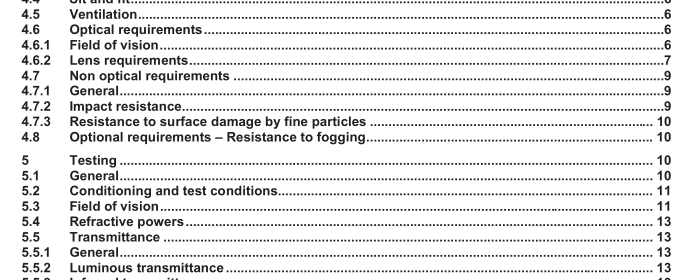EN 1938:2010 – Personal eye protection – Goggles for motorcycle and moped users

No parts of the goggles which are in contact with the wearer shall be made of materials that are known to cause irritation, allergic or toxic reaction amongst a significant proportion of users.
Examples for documents which can be presented as evidence of chemical innocuousness are given in the note below. NOTE The following list of documents is given for information and as examples of documents that can be examined when checking on the innocuousness of materials: materials specifications; safety data sheets relating to the materials; information relating to the suitability of the materials for use with food, in medical devices, or other relevant applications; information relating to toxicological, allergenic, carcinogenic, toxic to reproduction or mutagenic investigations on the materials; information relating to ecotoxicological and other environmental investigations on the materials.
The examination of documents or of the goggles shall determine whether the claim that the materials are suitable for use in the protective goggle is justified. Particular attention should be paid to the presence of plasticisers, unreacted components, heavy metals, impurities and the chemical identity of pigments and dyes.
All metallic materials which could come into prolonged contact with the skin (e.g. hinge, rim and bridge) shall be tested according to EN 1811 for nickel release. The release of nickel shall be less than 0,5 µg/cm 2 /wk.
4.4 Sit and fit Goggles shall be so designed and manufactured that they will sit securely in position on the face when used as intended, and will adapt to the shape of the wearer’s face by means of contact surfaces made of soft flexible material. The retaining strap shall be designed to be flexible or adjustable and sit securely when fitted according to the manufacturer’s instructions.
The retaining strap shall be capable of withstanding any stress which occurs during proper use without tearing or being permanently deformed. The verification of this requirement shall be made according to 5.12.
4.5 Ventilation Design measures shall exist ensuring that the inside of the goggles is ventilated during use. Such measures shall be outside the oculars’ areas and shall not reduce the peripheral vision significantly. The verification of this requirement shall be made with a visual inspection according to 5.11.
When goggle are provided with opening to allow circulation of air, the vented portion shall be such that openings shall exclude spherical objects 1,5 mm in diameter or larger. NOTE The necessary rate of air exchange and the design of the ventilation openings depend heavily on the weather, speed of driving and the individual conditions (e.g. sweating), which means that generally applicable requirements cannot be stipulated.
4.6 Optical requirements
4.6.1 Field of vision The size of the field of vision is defined in conjunction with the appropriate head-form described in Clause 17 of EN 168:2001. The goggles shall exhibit a minimum field of vision defined by the two ellipses in Figure 1 when placed and centred at a distance of 25 mm from the surface of the eyes of the appropriate head-form. The horizontal axis shall be parallel to and 0,7 mm below the height of the line connecting the centres of the two eyes.
The plane of the ellipses shall be parallel to the back flat portion of the head-form.
EN 1938:2010 – Personal eye protection – Goggles for motorcycle and moped users